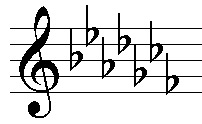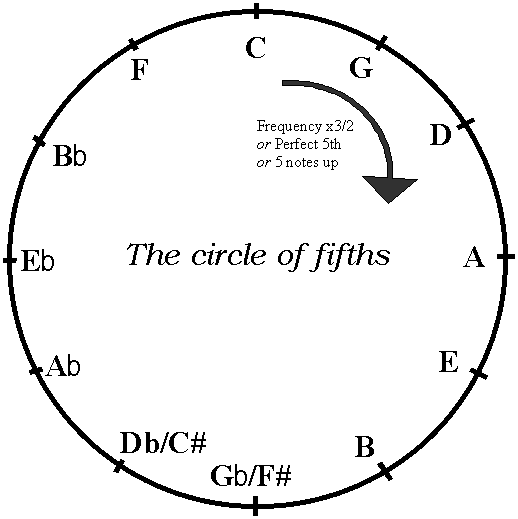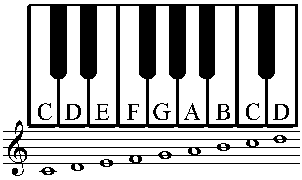- We previously learnt about common key signatures and how the key signature specifies the key, the scale and the key note.
- This table shows all possible key signatures and the major and minor keys they specify:
- It also shows which sharps and flats are in each key signature:
- So, for example, the key of Ab major (the fourth row down) has four flats in its key signature, and they are Bb, Eb, Db and Ab;
- The key of C# minor (fourth row up from the bottom) has four sharps in its key signature, and they are F#, C#, G# and D#.
- This makes very clear the patterns that exist in the sharps and flats of the key signatures - see the "circle of fifths" below.
Major scale/
key note | Minor scale/
key note | Sharps --> <--Flats
|
|---|
| F | C | G | D | A | E | B
|
|---|
| Cb | Ab | b | b | b | b | b | b | b
|
|---|
| Gb | Eb | | b | b | b | b | b | b
|
|---|
| Db | Bb | | | b | b | b | b | b
|
|---|
| Ab | F | | | | b | b | b | b
|
|---|
| Eb | C | | | | | b | b | b
|
|---|
| Bb | G | | | | | | b | b
|
|---|
| F | D | | | | | | | b
|
|---|
| C | A | | | | | | |
|
|---|
| G | E | # | | | | | |
|
|---|
| D | B | # | # | | | | |
|
|---|
| A | F# | # | # | # | | | |
|
|---|
| E | C# | # | # | # | # | | |
|
|---|
| B | G# | # | # | # | # | # | |
|
|---|
| F# | D# | # | # | # | # | # | # |
|
|---|
| C# | A# | # | # | # | # | # | # | #
|
|---|
- As is clear from this table, the sharps or flats in a key signature are always written in the same order, working from the left in the examples below, and they are always written in these positions on each stave:


- The key signature is written at the start of every line of music, not just the first one.
- The order of notes in the list of sharps and flats is the same (circularly) as the list of key signatures themselves: C, G, D, A, E, B, F.
- They are all the same as in the circle below.
- The next note going clockwise is calculated by going up five notes (counting inclusively)
- This is the same as increasing the frequency by 1.5 (3/2).

- Here is one explanation of why key signatures are needed, and what their purpose is:
- This might help you to understand the principles involved;
- But you don't need to know this to be able to sight-sing.
- To understand why a key signature specifies a key, and therefore why a key signature is necessary, we need to look again at the gaps between the notes of a major scale:

- From C to D is two semitones, from D to E is two semitones, but from E to F is only one semitone, and so on.
- So we can write a major scale as S2212221 where "S" means "Start note" and the numbers are the numbers of semitones that we ascend to get to the next note.
- Then if we start on the note D and try to make the same scale, with the same gaps ("intervals"), we get the notes D, E, F#, G, A, B, C#, D.
- So you can see that all F's and all C's have to be sharpened, hence we have a key signature of F# and C#
- You can perform the same exercise for any starting note, and you will end up with the table as above.





